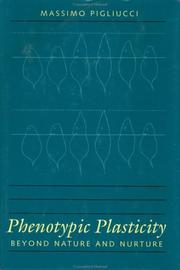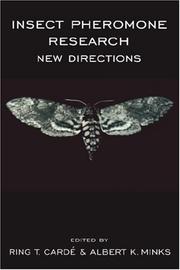| Listing 1 - 4 of 4 |
Sort by
|

ISBN: 0801867886 9780801867880 Year: 2001 Publisher: Baltimore Johns Hopkins University Press
Abstract | Keywords | Export | Availability | Bookmark
 Loading...
Loading...Choose an application
- Reference Manager
- EndNote
- RefWorks (Direct export to RefWorks)
For more than two decades the concept of phenotypic plasticity has allowed researchers to go beyond the nature-nurture dichotomy to gain deeper insights into how organisms are shaped by the interaction of genetic and ecological factors. 'Phenotypic Plasticity: Beyond Nature and Nurture' is the first work to synthesize the burgeoning area of plasticity studies, providing a conceptual overview as well as a technical treatment of its major components. Phenotypic plasticity integrates the insights of ecological genetics, developmental biology, and evolutionary theory. Plasticity research asks foundational questions about how living organisms are capable of variation in their genetic makeup and in their responses to environmental factors. For instance, how do novel adaptive phenotypes originate? How do organisms detect and respond to stressful environments? What is the balance between genetic or natural constraints (such as gravity) and natural selection? The author begins by defining phenotypic plasticity and detailing its history, including important experiments and methods of statistical and graphical analysis. He then provides extended examples of the molecular basis of plasticity, the plasticity of development, the ecology of plastic responses, and the role of costs and constraints in the evolution of plasticity. A brief epilogue looks at how plasticity studies shed light on the nature/nurture debate in the popular media. 'Phenotypic Plasticity: Beyond Nature and Nurture' thoroughly reviews more than two decades of research, and thus will be of interest to both students and professionals in evolutionary biology, ecology, and genetics.
General ecology and biosociology --- Genetics --- Phenotype. --- Genotype-environment interaction. --- Nature and nurture. --- Adaptation (Physiology) --- Phénotypes --- Interaction génotype-environnement --- Hérédité et milieu --- Adaptation (Physiologie) --- Phenotypic plasticity. --- Phénotypes --- Interaction génotype-environnement --- Hérédité et milieu --- Acqui 2006 --- Phenotypic plasticity

ISBN: 0195122348 0195122356 9780198028567 0198028563 128070389X 9781280703898 9786610703890 6610703892 0197561306 0199880735 9780195122350 9780195122343 9780197561300 Year: 2003 Publisher: Oxford ; New York : Oxford University Press,
Abstract | Keywords | Export | Availability | Bookmark
 Loading...
Loading...Choose an application
- Reference Manager
- EndNote
- RefWorks (Direct export to RefWorks)
Developmental Plasticity and Evolution is a comprehensive synthesis on development and evolution: it applies to all aspects of development, at all levels of organisation and in all organisms, taking advantage of modern findings on behaviour, genetics, endocrinology, molecular biology, evolutionary theory and phylogenetics to show the connections between developmental mechanisms and evolutionary change. This book solves key problems that have impeded a definitive synthesis in the past. It uses new concepts and specific examples to show how to relate environmentally sensitive development to the genetic theory of adaptive evolution and to explain major patterns of change.
Evolution. Phylogeny --- General embryology. Developmental biology --- Adaptation (Biology) --- Phenotype. --- Evolution (Biology) --- Developmental biology --- Adaptation (Biologie) --- Phénotypes --- Evolution (Biologie) --- Biologie du développement --- Developmental biology. --- Phenotypic plasticity. --- Adaptation (Biology). --- Evolution (Biology). --- Phénotypes --- Biologie du développement --- Development (Biology) --- Biology --- Growth --- Ontogeny --- Animal evolution --- Animals --- Biological evolution --- Darwinism --- Evolutionary biology --- Evolutionary science --- Origin of species --- Evolution --- Biological fitness --- Homoplasy --- Natural selection --- Phylogeny --- Phenotype --- Plasticity, Phenotypic --- Genotype-environment interaction --- Environment --- Self-organizing systems --- Variation (Biology) --- Genetics --- Plasticity --- Environmental adaptation --- Adaptation, Environmental --- Acqui 2006

ISBN: 0195143450 Year: 2003 Publisher: Oxford Oxford university press
Abstract | Keywords | Export | Availability | Bookmark
 Loading...
Loading...Choose an application
- Reference Manager
- EndNote
- RefWorks (Direct export to RefWorks)
The field of developmental instability has generated a large amount of controversy recently, mostly because of fierce disagreement over the genetic basis of fluctuating asymmetry and its role in mate selection. This book is a timely and innovative synthesis of the discussion. With twenty four chapters by leading authorities, the book is an especially thorough and critical treatment of the genetic basis of fluctuating asymmetry, and of its role in animal communication, sexual selection, and plant and animal ecology and evolution. The book features an in-depth examination of the relationship between environmental stress and asymmetry, as well as a critical assessment of the value of asymmetry as a biomarker in ecotoxicology. Up-to-date information from disparate fields within the biological sciences is creatively integrated to examine the molecular and cellular origins of developmental instability and fluctuating asymmetry, and the link between asymmetry and Darwinian fitness. This comprehensive treatment also describes methodology for data analysis and optimization of experimental design, refocuses attention on key problems in the field and identifies new research directions.
Developmental genetics. --- Developmental biology. --- Adaptation (Physiology) --- Phenotype. --- Genotype-environment interaction. --- Génétique du développement --- Biologie du développement --- Adaptation (Physiologie) --- Phénotypes --- Interaction génotype-environnement --- ontwikkelingsbiologie --- genetica (genen) --- Gene-environment interaction --- Genotype by environment interaction --- Genotype (times) environment interaction --- Genotype x environment interaction --- Interaction of environment and genotype --- Genetics --- Phenotype --- Phenotypes --- Genotype-environment interaction --- Compensation (Physiology) --- Plasticity (Physiology) --- Ecophysiology --- Development (Biology) --- Biology --- Growth --- Ontogeny --- Developmental biology --- Embryology --- biologie du développement --- génétique (gènes) --- Génétique du développement --- Biologie du développement --- Phénotypes --- Interaction génotype-environnement --- Developmental genetics

ISBN: 0412996111 1461379261 1461563712 Year: 1997 Publisher: New York Chapman & Hall
Abstract | Keywords | Export | Availability | Bookmark
 Loading...
Loading...Choose an application
- Reference Manager
- EndNote
- RefWorks (Direct export to RefWorks)
This book contains the proceedings of the "First International Symposium on Insect Pheromones," which was held at Wageningen, The Netherlands, from March 6 to March 11, 1994. Eighty participants from 17 countries attended the symposium, which turned out to be a unique forum for the exchange of the latest worldwide findings on insect pheromones, an opportunity to discuss and debate unsettled issues, and a mechanism to define new directions in pheromone research and foster interdisciplinary collaborations. The meeting comprised five sessions representing the breadth of disciplinary interest in pheromones, a typical charac teristic of this research area. In the sessions the following topics were presented: (1) control of pheromone production (organized by W. L. Roelofs), (2) sensory processing of pheromone signals (T. L. Payne), (3) neuroethology of pheromone mediated responses (T. C. Baker), (4) use of pheromones in direct control (A. K. Minks and R. T. Card6), and (5) evolution of pheromone communication (c. LOfstedt). All sessions started with a series of 30-minute lectures, after which ample time was reserved for discussion. In each session some participants were asked to serve as discussants and to initiate and stimulate discussion, and a rapporteur was recruited to make notes of these discussions and to summarize the general trends emerging from the session. The general program ming of the symposium was in the hands of R. T. Carde, A. K. Minks, and T. L. Payne.
Pheromones. --- Plant and Crop Sciences. Plant and Crop Protection --- Integrated Control, Integrated Pest Management. --- Pheromones --- Phéromones --- Hormones --- Semiochemicals --- Sex recognition (Zoology) --- Applied ecology. --- Ecology . --- Animal systematics. --- Animal taxonomy. --- Neurosciences. --- Applied Ecology. --- Ecology. --- Animal Systematics/Taxonomy/Biogeography. --- Neural sciences --- Neurological sciences --- Neuroscience --- Medical sciences --- Nervous system --- Animal classification --- Animal systematics --- Animal taxonomy --- Classification --- Systematic zoology --- Systematics (Zoology) --- Taxonomy, Animal --- Zoological classification --- Zoological systematics --- Zoological taxonomy --- Zoology --- Balance of nature --- Biology --- Bionomics --- Ecological processes --- Ecological science --- Ecological sciences --- Environment --- Environmental biology --- Oecology --- Environmental sciences --- Population biology --- Ecology --- Environmental protection --- Nature conservation --- Animals
| Listing 1 - 4 of 4 |
Sort by
|

 Search
Search Feedback
Feedback About UniCat
About UniCat  Help
Help News
News